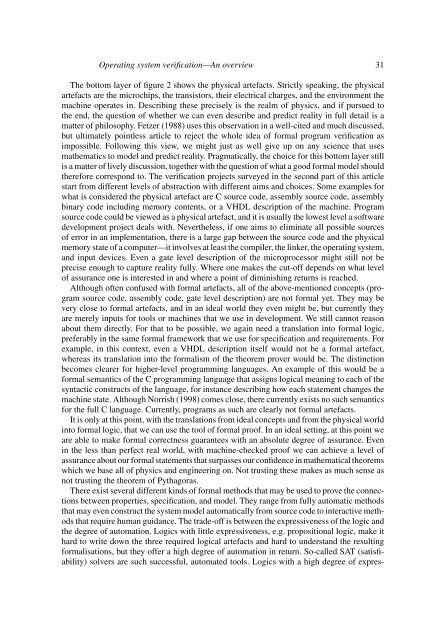Operating system verificationâAn overview
Operating system verificationâAn overview
Operating system verificationâAn overview
Create successful ePaper yourself
Turn your PDF publications into a flip-book with our unique Google optimized e-Paper software.
<strong>Operating</strong> <strong>system</strong> verification—An <strong>overview</strong> 31<br />
The bottom layer of figure 2 shows the physical artefacts. Strictly speaking, the physical<br />
artefacts are the microchips, the transistors, their electrical charges, and the environment the<br />
machine operates in. Describing these precisely is the realm of physics, and if pursued to<br />
the end, the question of whether we can even describe and predict reality in full detail is a<br />
matter of philosophy. Fetzer (1988) uses this observation in a well-cited and much discussed,<br />
but ultimately pointless article to reject the whole idea of formal program verification as<br />
impossible. Following this view, we might just as well give up on any science that uses<br />
mathematics to model and predict reality. Pragmatically, the choice for this bottom layer still<br />
is a matter of lively discussion, together with the question of what a good formal model should<br />
therefore correspond to. The verification projects surveyed in the second part of this article<br />
start from different levels of abstraction with different aims and choices. Some examples for<br />
what is considered the physical artefact are C source code, assembly source code, assembly<br />
binary code including memory contents, or a VHDL description of the machine. Program<br />
source code could be viewed as a physical artefact, and it is usually the lowest level a software<br />
development project deals with. Nevertheless, if one aims to eliminate all possible sources<br />
of error in an implementation, there is a large gap between the source code and the physical<br />
memory state of a computer—it involves at least the compiler, the linker, the operating <strong>system</strong>,<br />
and input devices. Even a gate level description of the microprocessor might still not be<br />
precise enough to capture reality fully. Where one makes the cut-off depends on what level<br />
of assurance one is interested in and where a point of diminishing returns is reached.<br />
Although often confused with formal artefacts, all of the above-mentioned concepts (program<br />
source code, assembly code, gate level description) are not formal yet. They may be<br />
very close to formal artefacts, and in an ideal world they even might be, but currently they<br />
are merely inputs for tools or machines that we use in development. We still cannot reason<br />
about them directly. For that to be possible, we again need a translation into formal logic,<br />
preferably in the same formal framework that we use for specification and requirements. For<br />
example, in this context, even a VHDL description itself would not be a formal artefact,<br />
whereas its translation into the formalism of the theorem prover would be. The distinction<br />
becomes clearer for higher-level programming languages. An example of this would be a<br />
formal semantics of the C programming language that assigns logical meaning to each of the<br />
syntactic constructs of the language, for instance describing how each statement changes the<br />
machine state. Although Norrish (1998) comes close, there currently exists no such semantics<br />
for the full C language. Currently, programs as such are clearly not formal artefacts.<br />
It is only at this point, with the translations from ideal concepts and from the physical world<br />
into formal logic, that we can use the tool of formal proof. In an ideal setting, at this point we<br />
are able to make formal correctness guarantees with an absolute degree of assurance. Even<br />
in the less than perfect real world, with machine-checked proof we can achieve a level of<br />
assurance about our formal statements that surpasses our confidence in mathematical theorems<br />
which we base all of physics and engineering on. Not trusting these makes as much sense as<br />
not trusting the theorem of Pythagoras.<br />
There exist several different kinds of formal methods that may be used to prove the connections<br />
between properties, specification, and model. They range from fully automatic methods<br />
that may even construct the <strong>system</strong> model automatically from source code to interactive methods<br />
that require human guidance. The trade-off is between the expressiveness of the logic and<br />
the degree of automation. Logics with little expressiveness, e.g. propositional logic, make it<br />
hard to write down the three required logical artefacts and hard to understand the resulting<br />
formalisations, but they offer a high degree of automation in return. So-called SAT (satisfiability)<br />
solvers are such successful, automated tools. Logics with a high degree of expres-
















